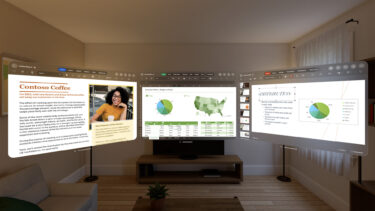Room planning, product design and spinal surgery: the wide range of applications for Apple Vision Pro

How SAP, Microsoft and others are using spatial computing — Apple presents use cases for Vision Pro in the enterprise.
In a comprehensive blog article, Apple presents new possibilities for companies to implement their work processes with Vision Pro. According to Apple, numerous developers are already working on Vision Pro applications for a variety of business areas. These include applications for increasing business productivity, collaborative product design, immersive training, and field service support.
Working with SAP and Microsoft 365 apps in Vision Pro
Major software vendors such as SAP and Microsoft are driving the integration of their solutions with Apple Vision Pro. SAP Analytics Cloud and SAP Mobile Start already use spatial computing to organize business processes and data in a spatially intuitive way. Microsoft 365 apps and the Copilot AI assistant are available for Vision Pro, creating productive workspaces on an infinite canvas with life-size windows.
Video: Apple
Vision Pro's high-resolution display visualizes 3D content in razor-sharp detail, opening up new possibilities for product design, spatial planning and construction modelling. The Porsche Race Engineer app, for example, enables engineers to collaborate in real time using vehicle data and live videos.
Video: Apple
Nvidia Omniverse Cloud APIs for Digital Twins
Nvidia Omniverse Cloud APIs stream massive 3D design and simulation datasets directly into Vision Pro. “The world’s industries are racing to build digital twins of products, facilities, and processes to better test and optimize designs well before constructing them in the physical world,” said Rev Lebaredian, Nvidia’s vice president of Omniverse and Simulation Technology. “Enterprises can now combine the power and capabilities of Apple Vision Pro and the physically accurate renderings of OpenUSD content with Nvidia accelerated computing to power the next generation of immersive digital experiences.”
The KLM Engine Shop app trains technicians on photorealistic 3D models of the latest engines. Detailed repair instructions are displayed directly above the engine. The goal is to reduce errors, increase employee satisfaction and reduce aircraft downtime.
Vision Pro applications also provide field workers with valuable contextual information about their surroundings. For example, the Resolve app helps building technicians analyze hidden systems such as HVAC and plumbing, while firefighters benefit from the FireOps app, which provides a unified view of operations plans, resources, and geospatial data.
Innovation potential for hospitals too
The technical specifications of the Apple Vision Pro, such as high-resolution displays, high refresh rates, large memory and multiple cameras, sensors, and a LiDAR scanner for 3D mapping of the environment, create the basis for powerful applications in companies.
Vision Pro is also already being used in hospitals. A successful example of a medical application is the use of Vision Pro during spinal surgery at London's Cromwell Hospital. The head operating room nurse wore the headset, which displayed important information on virtual screens. It supported her in preparing for the operation and selecting the right instruments for the surgeon.
A game changer with challenges
In my opinion, mixed reality has the potential to fundamentally change the way companies work, and not just with Apple's Vision Pro. Manufacturers such as Meta and HTC are also offering XR headsets for enterprise use. The ability to work spatially opens up new ways to optimize processes, train employees, and improve collaboration.
I am particularly impressed with the product development and medical applications. If engineers can test concepts faster and cheaper, and surgeons can be supported with better information, the benefits can be enormous.
But I also see some challenges. Companies need to train their employees to use the new technology and plan the integration carefully. Data protection, occupational health and safety, and acquisition costs should also not be underestimated.
Overall, however, I believe the benefits outweigh the drawbacks. If companies can harness the potential of mixed reality in the right areas, they can gain a real competitive advantage.
Note: Links to online stores in articles can be so-called affiliate links. If you buy through this link, MIXED receives a commission from the provider. For you the price does not change.